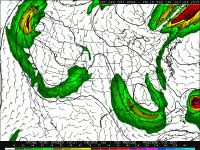MClarkson
EF5
With the 01/12Z models in, the HWRF has now flipped to the offshore solution, leaving CMC/GFDL with tracks into the outer banks and GFS/EURO/HWRF far offshore. Still plenty of disagreement/uncertainty.
What effect does the cutoff low have on the hurricane?
Sent from my SCH-I545 using Tapatalk
What effect does the cutoff low have on the hurricane?
Sent from my SCH-I545 using Tapatalk
With the 01/12Z models in, the HWRF has now flipped to the offshore solution, leaving CMC/GFDL with tracks into the outer banks and GFS/EURO/HWRF far offshore. Still plenty of disagreement/uncertainty.
The thought was that the trough would "capture" the hurricane and help bring it in northwest toward the coast - envision it moving counterclockwise up and around the cutoff low - I think this is known as a fujiwara effect. But I am not sure what makes the difference between this occurring, OR the trough instead kicking the hurricane offshore as Mike suggested. I assume it has something to do with the exact timing/phasing and position/orientation of each feature when the trough and hurricane are close enough to each other to interact.



This fellow does a very good job explaining the forecast difficulties that the models have been struggling with.What effect does the cutoff low have on the hurricane?
Sent from my SCH-I545 using Tapatalk
Nice, thanks! Makes plenty sense, and now can see why the timing really is everythingThis fellow does a very good job explaining the forecast difficulties that the models have been struggling with.
From what I can see of the spaghetti maps, there is almost no chance that the storm follows anything close to the official NHC track - it either makes landfall in the Carolinas OR goes OTS.
Sent from my iPhone using Tapatalk

